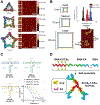The dynamic, motile and deformative properties of RNA nanoparticles facilitate the third milestone of drug development
- PMID: 35526663
- PMCID: PMC9257724
- DOI: 10.1016/j.addr.2022.114316
The dynamic, motile and deformative properties of RNA nanoparticles facilitate the third milestone of drug development
Abstract
Besides mRNA, rRNA, and tRNA, cells contain many other noncoding RNA that display critical roles in the regulation of cellular functions. Human genome sequencing revealed that the majority of non-protein-coding DNA actually codes for non-coding RNAs. The dynamic nature of RNA results in its motile and deformative behavior. These conformational transitions such as the change of base-pairing, breathing within complemented strands, and pseudoknot formation at the 2D level as well as the induced-fit and conformational capture at the 3D level are important for their biological functions including regulation, translation, and catalysis. The dynamic, motile and catalytic activity has led to a belief that RNA is the origin of life. We have recently reported that the deformative property of RNA nanoparticles enhances their penetration through the leaky blood vessel of cancers which leads to highly efficient tumor accumulation. This special deformative property also enables RNA nanoparticles to pass the glomerulus, overcoming the filtration size limit, resulting in fast renal excretion and rapid body clearance, thus low or no toxicity. The biodistribution of RNA nanoparticles can be further improved by the incorporation of ligands for cancer targeting. In addition to the favorable biodistribution profiles, RNA nanoparticles possess other properties including self-assembly, negative charge, programmability, and multivalency; making it a great material for pharmaceutical applications. The intrinsic negative charge of RNA nanoparticles decreases the toxicity of drugs by preventing nonspecific binding to the negative charged cell membrane and enhancing the solubility of hydrophobic drugs. The polyvalent property of RNA nanoparticles allows the multi-functionalization which can apply to overcome drug resistance. This review focuses on the summary of these unique properties of RNA nanoparticles, which describes the mechanism of RNA dynamic, motile and deformative properties, and elucidates and prepares to welcome the RNA therapeutics as the third milestone in pharmaceutical drug development.
Keywords: Cancer treatment; Deformative property; Drug delivery; Drug development; RNA dynamics; RNA nanotechnology; Ribonucleic acid (RNA).
Copyright © 2022 Elsevier B.V. All rights reserved.
Conflict of interest statement
Declaration of Competing Interest The authors declare the following competing financial interests: P.G. is the consultant, licensor, and grantee of Oxford Nanopore Technologies; as well as the cofounder, chairman of the board of directors, and president of the ExonanoRNA, LLC.
Figures









Similar articles
-
In Vitro and In Vivo Evaluation of the Pathology and Safety Aspects of Three- and Four-Way Junction RNA Nanoparticles.Mol Pharm. 2024 Feb 5;21(2):718-728. doi: 10.1021/acs.molpharmaceut.3c00845. Epub 2024 Jan 12. Mol Pharm. 2024. PMID: 38214504 Free PMC article.
-
Targeted Delivery of Potent Chemical Drugs and RNAi to Drug-Resistant Breast Cancer Using RNA-Nanotechnology and RNA-Ligand Displaying Extracellular vesicles.RNA Nanomed. 2024;1(1):16-43. doi: 10.59566/isrnn.2024.0101016. RNA Nanomed. 2024. PMID: 40125243 Free PMC article.
-
Stable RNA nanoparticles as potential new generation drugs for cancer therapy.Adv Drug Deliv Rev. 2014 Feb;66:74-89. doi: 10.1016/j.addr.2013.11.006. Epub 2013 Nov 22. Adv Drug Deliv Rev. 2014. PMID: 24270010 Free PMC article. Review.
-
Tuning the size, shape and structure of RNA nanoparticles for favorable cancer targeting and immunostimulation.Wiley Interdiscip Rev Nanomed Nanobiotechnol. 2020 Jan;12(1):e1582. doi: 10.1002/wnan.1582. Epub 2019 Aug 27. Wiley Interdiscip Rev Nanomed Nanobiotechnol. 2020. PMID: 31456362 Free PMC article. Review.
-
Radiolabeled RNA Nanoparticles for Highly Specific Targeting and Efficient Tumor Accumulation with Favorable In Vivo Biodistribution.Mol Pharm. 2021 Aug 2;18(8):2924-2934. doi: 10.1021/acs.molpharmaceut.1c00035. Epub 2021 Jul 2. Mol Pharm. 2021. PMID: 34212728 Free PMC article.
Cited by
-
In Vitro and In Vivo Evaluation of the Pathology and Safety Aspects of Three- and Four-Way Junction RNA Nanoparticles.Mol Pharm. 2024 Feb 5;21(2):718-728. doi: 10.1021/acs.molpharmaceut.3c00845. Epub 2024 Jan 12. Mol Pharm. 2024. PMID: 38214504 Free PMC article.
-
MMP-2 Responsive Gold Nanorods Loaded with HSP-70 siRNA for Enhanced Photothermal Tumor Therapy.Mol Pharm. 2024 Nov 4;21(11):5455-5468. doi: 10.1021/acs.molpharmaceut.4c00188. Epub 2024 Oct 18. Mol Pharm. 2024. PMID: 39424288 Free PMC article.
-
Aptamer-targeted anti-miR RNA construct based on 3WJ as a new approach for the treatment of chronic kidney disease in an experimental model.Gene Ther. 2025 Jul;32(4):359-375. doi: 10.1038/s41434-025-00544-7. Epub 2025 Jun 14. Gene Ther. 2025. PMID: 40514411 Free PMC article.
-
Conversion of Chemical Drugs into Targeting Ligands on RNA Nanoparticles and Assessing Payload Stoichiometry for Optimal Biodistribution in Cancer Treatment.RNA Nanomed. 2024;1(1):109-123. doi: 10.59566/isrnn.2024.0101109. RNA Nanomed. 2024. PMID: 40125244 Free PMC article.
-
Editorial to "Molecular engineering of biomaterials programmed to operate in living systems".Adv Drug Deliv Rev. 2023 Feb;193:114669. doi: 10.1016/j.addr.2022.114669. Epub 2022 Dec 15. Adv Drug Deliv Rev. 2023. PMID: 36529189 Free PMC article. No abstract available.
References
-
- Baranello G, Darras BT, Day JW, Deconinck N, Klein A, Masson R, Mercuri E, Rose K, El-Khairi M, Gerber M, Gorni K, Khwaja O, Kletzl H, Scalco RS, Seabrook T, Fontoura P, Servais L, Group FW, Risdiplam in Type 1 Spinal Muscular Atrophy, N Engl J Med 384 (2021) 915–923, 10.1056/NEJMoa2009965. - DOI - PubMed
Publication types
MeSH terms
Substances
Grants and funding
LinkOut - more resources
Full Text Sources
Medical

